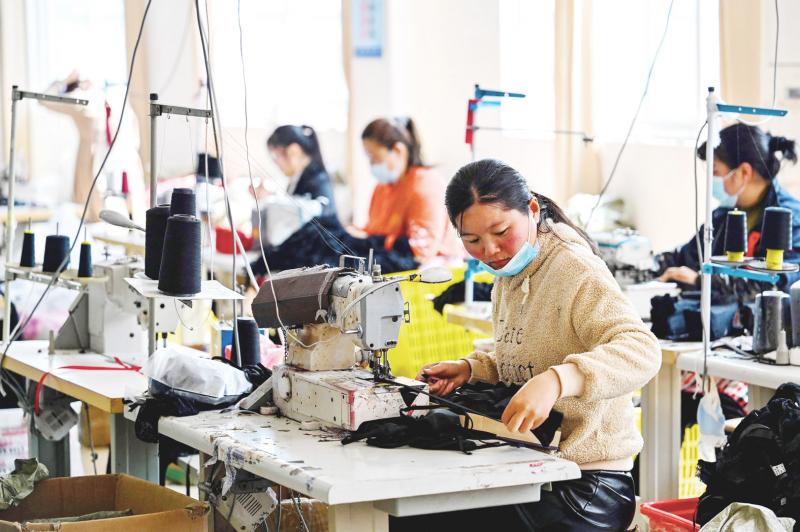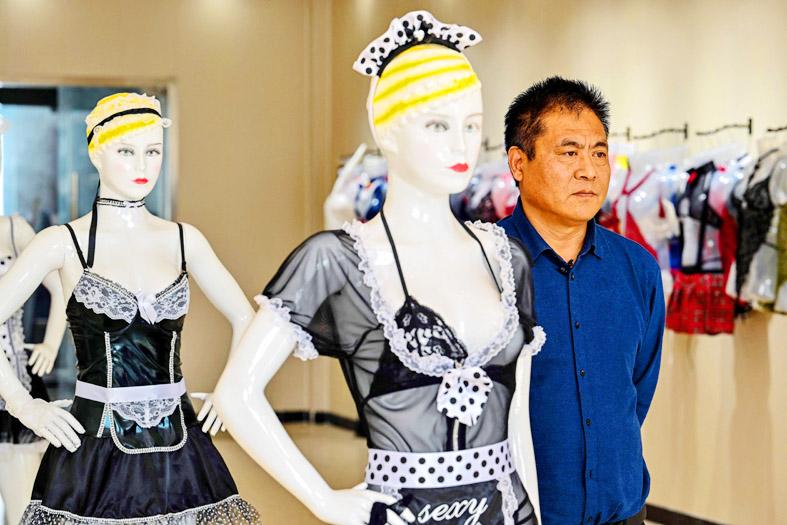Americans like their lingerie to be risque, Europeans prefer it classier, and Chinese remain a bit shy, but are opening up — but the biggest order of all came from North Korea.
So goes the street-corner discussion in Guanyun, a coastal county that for generations followed the rhythms of wheat and rice cultivation, but today concerns itself with global lingerie preferences.
The flat farming region between Beijing and Shanghai is China’s self-proclaimed “Lingerie Capital,” where sewing machines hum in village micro-factories to meet up to 70 percent of the fast-growing domestic demand.

Photo: AFP
Millions more items are exported annually in a textbook example of the ability of Internet-enabled Chinese entrepreneurs to profit from even the most off-the-wall idea.
The man widely credited with lighting the spark is Lei Congrui, a lanky 30-year-old with a ponytail and cap who would look at home on a skateboard. It all happened almost by accident.
As a teenager 15 years ago, Lei began making extra cash by hawking various consumer goods on the country’s growing e-commerce sites.

Photo: AFP
“Customers kept asking if we have any lingerie. I had never heard of it before, but I just said: ‘Yes,’ and then looked up what it was,” he said.
Lei “figured out a way” and now employs more than 100 workers who push lacy black and red panties, and bustiers through stitching machines.
His brands, such as “Midnight Charm,” pull in more than US$1.5 million in annual revenue, he said.
The success of early movers such as Lei inspired an industrial revolution.
The Guanyun Provincial Government said that there are more than 500 factories employing tens of thousands, and churning out more than US$300 million of lingerie annually.
Loosening Chinese sexual attitudes made it all possible.
Communism left a prevailing legacy of modesty. Pornography is banned and authorities launch periodic crackdowns on anything deemed “vulgar.”
However, prolonged exposure to more open foreign attitudes is liberating a younger generation, especially women.
Market consultancy iiMedia said that Chinese online sales of sex-related products grew 50 percent in 2019 to US$7 billion. It predicted 35 percent growth last year, despite fallout from the COVID-19 pandemic.
“Attitudes of the young are catching up and bringing sensuality into the home. [Lingerie] is becoming popular,” said Li Yue, a local lingerie factory worker.
When Lei first started, most buyers were more than 30, and many had lived abroad or had some other exposure to foreign ways.
However, by about 2013, volumes jumped as a younger generation of Chinese consumers began discovering their sensuality, Lei said, adding that most buyers are now aged 22 to 25.
Initially, loose-fitting, not-too-revealing designs were favored in China, but today, semi-transparent, “body-hugging” numbers dominate.
Guanyun’s industrial reinvention did not happen overnight. Early pioneers found it difficult to hire squeamish local staff.
“When they first came in contact with these things, they didn’t quite understand,” said Chang Kailin, 58, who runs a factory and is Lei’s uncle. “But after the industry got bigger and stronger, people could make money and shake off poverty. Now everyone loves it.”
Lei exports 90 percent of his output, mostly to the US and Europe. Significant volumes also go to South America, where sales indicate role-playing costumes rule the bedroom.
Middle Eastern buyers — favoring longer, more modest items — are also surprisingly active, as are Africans, who like a splash of color. Southeast Asia is growing fast as well.
However, Lei’s biggest single order — worth US$1 million — came from a mysterious North Korean buyer in 2012, but the customer abruptly backed out without explanation and the merchandise was sold elsewhere.
Lingerie has transformed Guanyun, with factories sprouting up next to wheat fields, and newfound wealth displayed in new homes and vehicles.
Previously, many of the county’s about 1 million inhabitants left for the hard life of a migrant worker in far-off factories.
No more, said Li, the garment worker.
“Working away from home, you get homesick,” the mother of two said. “These companies allow us to come home to work. It’s not easy out there.”
Guanyun has broken ground on a US$500 million, 690-hectare lingerie-themed industrial zone that is to “integrate research and development and design, fabric accessories, e-commerce operations, warehousing and logistics.”
Pandemic lockdowns last year hit output. It has since roared back, but demand remains tepid in overseas markets still struggling with COVID-19, while home-bound consumers are concentrating spending on basic household necessities, Lei said.
“After these problems are solved,” he said, smiling. “They will be ready to play again.”

PARLIAMENT CHAOS: Police forcibly removed Brazilian Deputy Glauber Braga after he called the legislation part of a ‘coup offensive’ and occupied the speaker’s chair Brazil’s lower house of Congress early yesterday approved a bill that could slash former Brazilian president Jair Bolsonaro’s prison sentence for plotting a coup, after efforts by a lawmaker to disrupt the proceedings sparked chaos in parliament. Bolsonaro has been serving a 27-year term since last month after his conviction for a scheme to stop Brazilian President Luiz Inacio Lula da Silva from taking office after the 2022 election. Lawmakers had been discussing a bill that would significantly reduce sentences for several crimes, including attempting a coup d’etat — opening up the prospect that Bolsonaro, 70, could have his sentence cut to

China yesterday held a low-key memorial ceremony for the 1937 Nanjing Massacre, with Chinese President Xi Jinping (習近平) not attending, despite a diplomatic crisis between Beijing and Tokyo over Taiwan. Beijing has raged at Tokyo since Japanese Prime Minister Sanae Takaichi last month said that a hypothetical Chinese attack on Taiwan could trigger a military response from Japan. China and Japan have long sparred over their painful history. China consistently reminds its people of the 1937 Nanjing Massacre, in which it says Japanese troops killed 300,000 people in what was then its capital. A post-World War II Allied tribunal put the death toll

A passerby could hear the cacophony from miles away in the Argentine capital, the unmistakable sound of 2,397 dogs barking — and breaking the unofficial world record for the largest-ever gathering of golden retrievers. Excitement pulsed through Bosques de Palermo, a sprawling park in Buenos Aires, as golden retriever-owners from all over Argentina transformed the park’s grassy expanse into a sea of bright yellow fur. Dog owners of all ages, their clothes covered in dog hair and stained with slobber, plopped down on picnic blankets with their beloved goldens to take in the surreal sight of so many other, exceptionally similar-looking ones.

‘UNWAVERING ALLIANCE’: The US Department of State said that China’s actions during military drills with Russia were not conducive to regional peace and stability The US on Tuesday criticized China over alleged radar deployments against Japanese military aircraft during a training exercise last week, while Tokyo and Seoul yesterday scrambled jets after Chinese and Russian military aircraft conducted joint patrols near the two countries. The incidents came after Japanese Prime Minister Sanae Takaichi triggered a dispute with Beijing last month with her remarks on how Tokyo might react to a hypothetical Chinese attack on Taiwan. “China’s actions are not conducive to regional peace and stability,” a US Department of State spokesperson said late on Tuesday, referring to the radar incident. “The US-Japan alliance is stronger and more